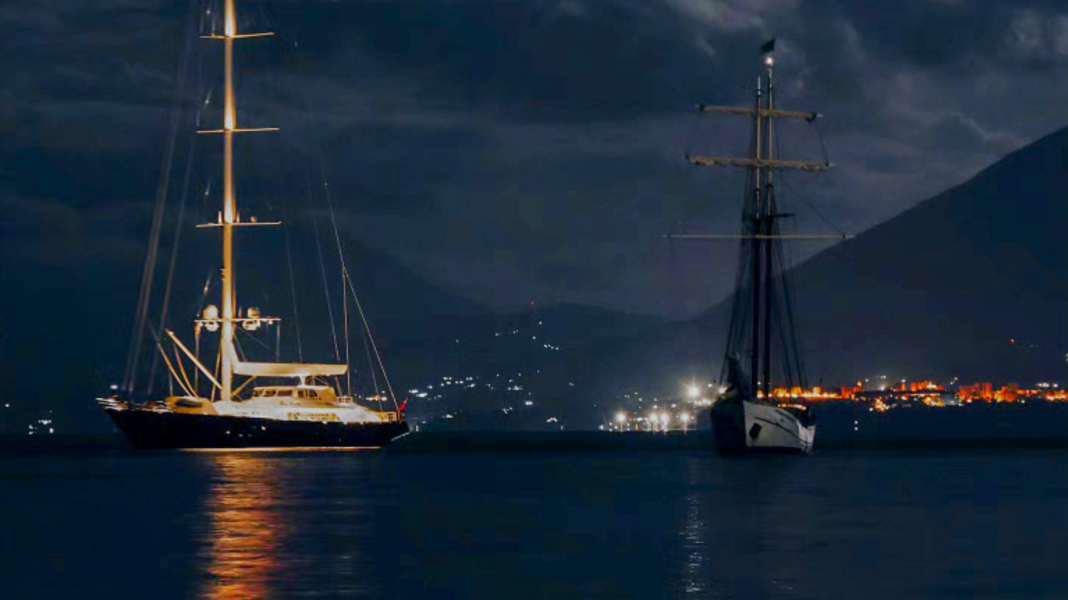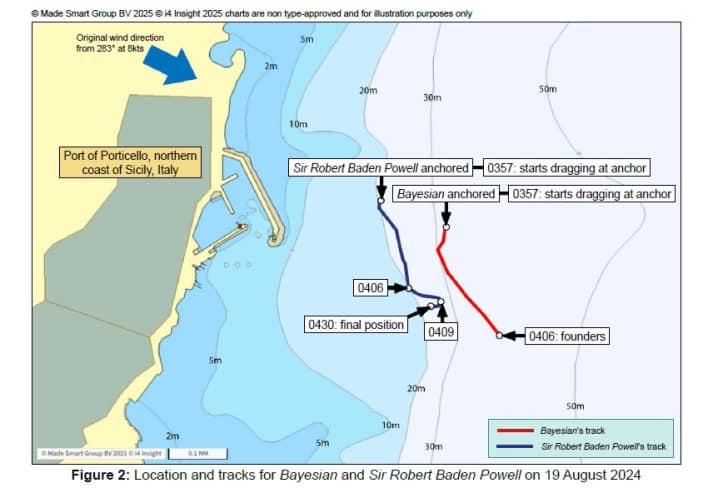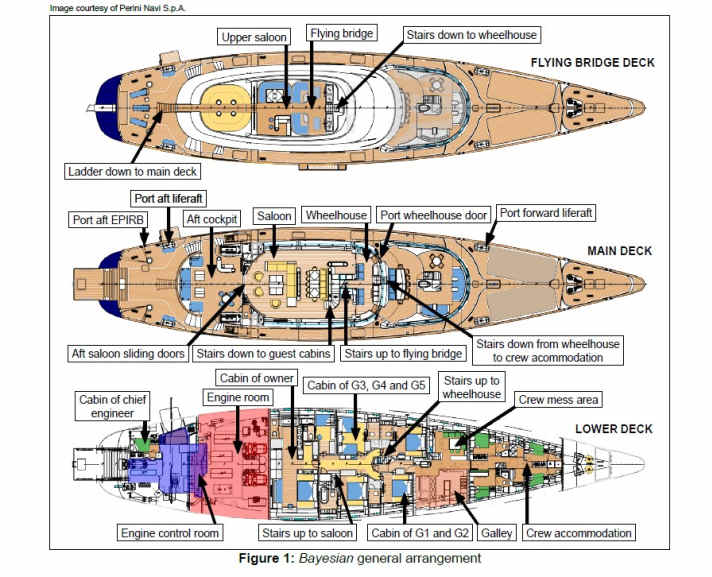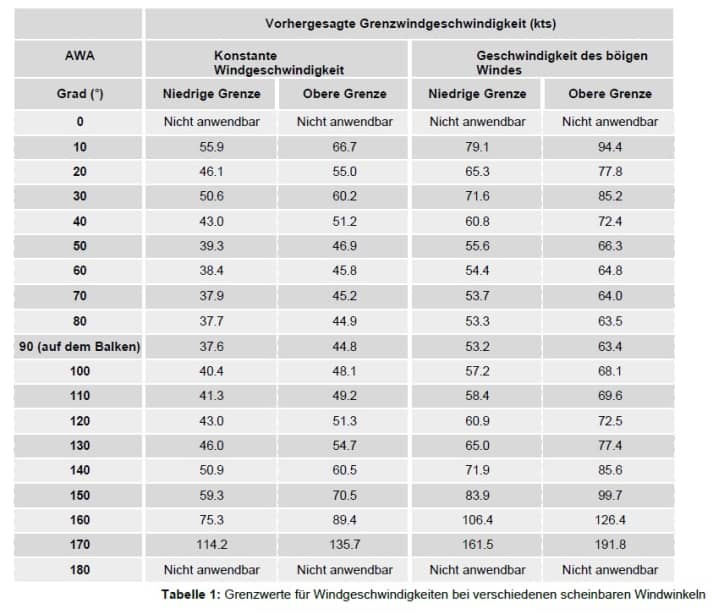
Speculation about the cause of the accident
Since the sinking of the aluminium yacht, there have been various speculations about possible causes: open hull flaps, too much windage with too little stability, crew failure or even an assassination attempt. They have been circulating in the media and behind closed doors. The British investigation report deliberately ignores all speculation and relies exclusively on reliable information. "This includes the Bayesian's design, stability, escape routes, operation and emergency procedures. The safety investigation also took into account the weather forecast and the weather during the accident, as well as available advice for seafarers on what to do in extreme weather conditions," it reads. In the end, however, one of the assumptions could be confirmed.
Described in minute detail: the dramatic events of the night of the accident
After a trip to the Aeolian Islands north of Sicily, the superyacht "Bayesian" is moored near Cefalù on 18 August 2024 with twelve guests and ten crew members at anchor. Due to rising winds, the crew moves on to Porticello to spend a calmer night there. At 21:24, the "Bayesian" drops anchor east of Porticello's main pier, presumably with her keel raised. The weather is calm, with a light north-westerly wind. Thunderstorms are forecast, and occasionally the crew and guests notice the first flashes of lightning in the west.
The last guest goes to bed at 00:30. Deckhand and steward take over the night watch. At around 03:00, the storm approaches, and half an hour later the danger of an approaching storm becomes clear. Shortly before four, a crew member takes a video of the approaching storm and shares it on social media. These are the last quiet minutes on board. The weather conditions are deteriorating rapidly. The "Bayesian" and the "Sir Robert Baden Powell" anchored nearby begin to drift. Both ships lift anchor.

Fatal capsize
At 4.06 am, the crisis reaches its climax: in a violent squall, the "Bayesian" tilts 90° to starboard in just 15 seconds. One crew member is thrown from the ship, others are injured. Furniture and loose objects fly around. The generators switch off immediately, only the battery-powered emergency lighting remains in operation. Within a very short time, the water enters via the starboard railing and floods the interior via the stairwells.
In the chaotic minutes that followed, the crew and guests tried to save themselves from the sinking ship. Some managed to escape through the forward port door of the wheelhouse. Others were thrown out of their bunks, found hold of furniture and fought their way up the walls of the staircase. The captain orders the evacuation. At 4.22 a.m., the crew manages to release a life raft in the chaos. Some of the crew make it directly to the life raft, while others are adrift in the stormy sea. The "Bayesian" sinks at around 4.45 am.
The neighbouring yacht "Sir Robert Baden Powell" notices the shipwrecked men's distress signals and sends its dinghy to rescue them. At 4.53 am, the first survivors are brought on board the "Sir Robert Baden Powell". The local coastguard launched an intensive search for more survivors. Despite all efforts, six guests and one crew member can only be recovered dead.

Meteorologists assume a supercell
The weather reports had initially forecast westerly winds of force 3 or 4 for 18 August, which were to shift to the northwest at times and increase to wind forces of 4 to 5 at the end. The sea was initially expected to be calm. However, there were warnings of showers, thunderstorms and poor visibility during the night. A storm warning was issued for Sardinia, Corsica and Sicily in particular.
At around 21:00 UTC on 18 August, a nearby weather station northwest of the anchorage in Porticello measured a sudden increase in wind from around 5 knots to 41 knots, combined with violent gusts, thunderstorms and heavy rain. On the webcams in Porticello, furniture and debris could be seen hurling through the air: Extreme wind speeds were reached in a very short space of time.
The Met Office, the UK's national weather service, has analysed satellite images and weather data from the night of the accident and concluded that a low-pressure system with extremely high energy passed over the area. The high temperatures near sea level provided additional energy. Satellite images showed a massive storm front with the characteristics of a supercell, which could cause surface winds of more than 87 knots. Meteorologists believe it is very likely that the "Bayesian" was hit by one of these with full force, possibly combined with tornado water fountains and extremely strong downdrafts - a weather phenomenon that can occur in extremely limited areas, around 50 to 100 metres wide. Extreme conditions that are likely to put any yacht in dire straits.
Doubts about the Stability of the superyacht
With the possible stability of the "Bayesian", the investigation report addresses a further - and as it turns out very critical - component in the chain of events. A detailed stability analysis of the 56-metre yacht was carried out as part of the accident investigation. The Wolfson Unit for Marine Technology and Industrial Aerodynamics at the University of Southampton created a stability model based on the vessel's Stability Information Booklet (SIB) approved in 2008 by the then Large Yacht Service of the UK Maritime and Coastguard Agency (MCA).
The SIB had to contain static stability curves (so-called GZ curves) for certain loading conditions, including at least the loaded departure and arrival conditions with 100 % and 10 % full tanks respectively. The GZ curves should actually have a positive range of at least 90°; however, ships with a length of more than 45 metres may deviate from this.
The SIB of the "Bayesian" contained curves for the sailing conditions in different load states, always with the keel lowered. The three stability angles recorded in the SIB are between 84.3° and 92.3°. It also included curves for the maximum steady heeling angle to prevent swamping in gusts. These curves indicate a safe operating range for a sailing vessel - and the maximum heel angle it can sustain before there is a risk of swamping in a sudden gust or squall.
The study now revealed that the 72 metre high mast alone was responsible for 50% of the total wind heeling moment when the wind came from the side, as it did on the night of the accident. Based on the assumption that the ship was lying in the bay with the centreboard raised, the angle of stability was only 70.6° according to the calculations.
Critical wind speeds
The "Bayesian" heeled to 90 degrees and was therefore far beyond the possibility of righting itself again. The wind that hit the mast was probably sufficient for this: the investigation report concludes that a gusting wind speed of more than 63.4 knots would probably cause the ship to capsize in a direct crosswind. This critical wind speed is significantly lower than the wind speeds that actually occurred during the storm. Fatal: this weak point was not explicitly stated in the ship's stability information book. It only contained stability curves for operation under sail. The skipper and crew could only guess at her behaviour under engine power, as was the case at the time of the accident.

Alarming findings
Andrew Moll, Chief Inspector of Marine Casualties, summarises the outcome of the investigation to date: "The interim report is a desktop study of the facts as we know them. The study has analysed the stability of the yacht, the likely local weather conditions at the time and the impact of that weather on the yacht. The results show that the extreme wind to which Bayesian was exposed was sufficient to cause the yacht to capsize. Once the yacht had heeled beyond an angle of 70°, the situation was unsalvageable. The results will be refined as the investigation progresses and more information becomes available."
The safety investigation into the sinking of the "Bayesian" is therefore not yet complete. The investigation of the wreck after of the recently started salvage should provide a better understanding of the actual state of the damage - in particular the actual loading, the deadweight, possible flooding points and the position of the centreboard at the time of the accident. The report concludes logically: "Until the investigation work is completed and the final report is published, the content of this interim report should be understood as an indication of the circumstances of the accident."

